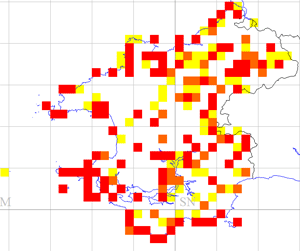Raven - 2003-07
 Monday, August 20, 2012 at 7:41PM
Monday, August 20, 2012 at 7:41PM Although Ravens are found mainly on the coast of Pembrokeshire, breeding on sea cliffs on the mainland and on the offshore islands, they occur quite widely in the open hilly areas and also across lowland farmland where there are suitable natural outcrops, quarries or wooded areas with mature trees for nest sites.
Raven nests are quite large bulky structures and most are usually not too difficult to locate. Within a territory they may utilise one of several alternative nest sites in a particular year. In some years old, unused nests can be taken over by other species such as Peregrines.
Using only confirmed and probable breeding categories, because of the likelihood of wandering non-breeding or foraging adult birds being included in the possible breeding category, Ravens were found in 133 tetrads during the 1984-88 atlas period. During the 2003-07 atlas survey, they were found in 144 tetrads, based on the same breeding categories, a small and probably insignificant increase of 8%. However, the proportion found at inland tetrads was higher, approximately 70 tetrads during 2003-07, compared with 57 tetrads in 1984-88, an increase of about 23%.
Donovan and Rees (1994) estimated that during the period 1984-88, the total breeding population was about 140 pairs. Of these 12 pairs were reported on the offshore islands, at least 65 pairs were breeding around the outer coast and the inland population was estimated to be about 60 pairs.
The locations of Raven nest-sites along the south Pembrokeshire coast were recorded during the most recent tetrad-based breeding survey (2003-07). This was done to help inform an assessment of the mainland coastal Raven breeding population during the latter atlas period. Occupied Raven nest sites were plotted on a map between Angle (Sheep Island) and Penally, a sample distance of a distance of about 42 km. (Haycock, unpublished data).
The average breeding population in this region in most years of the survey period was 12 pairs (about one pair every 3.5 km). The total length of coastline checked also included unsuitable habitat such as sandy bays/beaches etc, so the density is closer to one pair every 3 km if only suitable coastal nesting habitat is included.
If this linear density is representative of the whole of the Pembrokeshire coastline (estimated to be about 246 km long, based on the length of the National Trail on the open coast and the outer mainly cliff-sections of Milford Haven, as far up the waterway as Milford Haven and Pembroke Dock) then the mainland coastal breeding population could be as high as approximately 70 pairs. Numbers of pairs reported breeding on the offshore islands in 2003-07 were generally similar to those reported during the earlier atlas period.
Assessing the breeding density of the inland population is more difficult as, being quite widely dispersed, they are not so easy to census. Most of the mature woodland and forestry blocks in the county are probably occupied by at least one pair. As the number of inland tetrads with confirmed or probable breeding records appears to have increased over the last 20 years, assuming the original population estimate to be reasonable, then it is unlikely that the inland population is less than 60 pairs.
When combined with the coastal and island breeding pairs, a total population of not less than 140 pairs, and possibly up to 150 pairs seems quite a reasonable estimate.
Bob Haycock.

Fieldwork 2003-07 (based on 490 tetrads)
Red = breeding confirmed = 108
Orange = breeding probable = 36
Yellow = birds reported but with no signs of breeding
Total tetrads in which registered = 144 (29.4%)
Inland breeding tetrads= 70 (48.6% of breeding tetrads)
 PBBA 2003-7,
PBBA 2003-7,  RJH in
RJH in  Raven
Raven 

Reader Comments